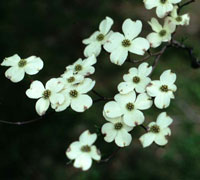


Home
Flowers &
Indoor Plants
Fruits & Nuts
Ornamentals
Vegetables
Special Topics
Resources
Glossary

|
Flowering Dogwood Cornus florida (corn-us flor-ih-dah)     Click on thumbnails for larger image. |
 |
What about it? The flowering dogwood is a small, deciduous understory tree native to North America. It has a round shape and a horizontal branching habit. The leaves of the dogwood are arranged opposite one another and have a whitish tinge underneath. The flowers are yellowish-green and bloom in mid-May. The fruit of the dogwood is red and in the fall the leaves will turn red as well. The bark of the flowering dogwood is referred to as alligator bark because of its unusual checkered design. A dogwood can grow up to 30 feet tall. What is it used for? The flowering dogwood is one of the most popular landscape trees in North America. This is probably because of its small size and seasonal interest, i.e., springtime flowers and fruit, bright autumn leaves, and winter buds and bark. Where does it grow? How do we grow it? The flowering dogwood can grow in either sun or shade. However, for the best flowering, a dogwood should be grown in slight shade. These trees also prefer moist, fertile, well-drained, preferably acidic soils. They should be spaced 25 feet apart. What are its primary problems? Flowering dogwood flower buds are susceptible to winter injury from very cold weather. However, in milder climates the flowering dogwood is susceptible to crown rot as well as the dreadful dogwood borer. Also, canker has become quite prevalent in some areas. Dogwood anthracnose can be a limiting factor. In fact, anthracnose epidemics are destroying many dogwoods in the U.S. Kousa dogwood is more resistant to the disease and is recommended for planting.
© Copyright, Department of Horticulture, Cornell University. |